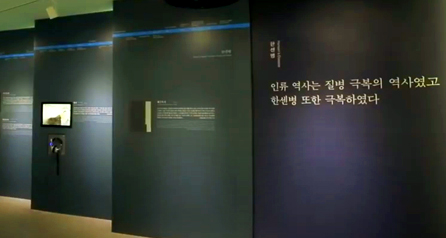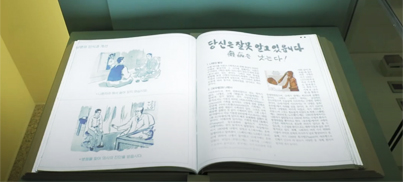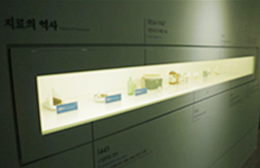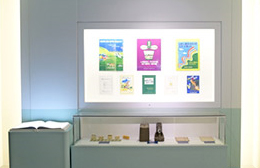Hansen’s Disease
Permanent Exhibition is displayed in the Centennial Hall on the second floor of the Museum.
It is composed of six different zones by theme: Hansen’s Disease, Human Rights, Space Transition, Life, Sorokdo National Hospital, and Friends. Various artifacts and materials such as artifacts used by Hansen’s disease patients (8 types, 14 items including a personal knife used for self-treatment), which are designated as Registered Cultural Heritage No. 663, are displayed to help you understand the history of Sorokdo and Hansen’s disease and sympathize with the life of patients and the value of human rights.
In the Hansen’s Disease Zone, you will be able to learn proper knowledge about Hansen’s disease and the history of Hansen’s disease treatment.


Hansen’s disease is a skin disease caused by mycobacterium leprae infection. It was feared dreadfully in the past. Nowadays, however, it is curable thanks to the multi-drug therapy (MDT) and the disease no longer has to be feared for being contagious.
In Korea, records of Hansen’s disease remains in the Veritable Records of the Joseon Dynasty. The history of overcoming Hansen’s disease began in earnest with the establishment of leprosariums across the nation by missionaries during the late period of the Joseon Dynasty and the opening of Jahye Hospital in Sorokdo in 1916.
The disease began to be cured as treatment medicines became available after the liberation from the Japanese Colonial Rule. There are only few patients as of today.
In the past, Hansen’s disease patients were subject to social prejudice. Therefore, treating the disease required efforts to enhance social perception of the disease, along with medical treatment.
This is why Dr. Lew Joon said that Hansen’s disease should be treated by concurrently addressing medical, psychological, and socioeconomic problems.
Exhibits & Collections
-
 Hansen’s Disease Medicines
Hansen’s Disease MedicinesMedicines used for treating Hansen’s disease are displayed in this zone. The first one is Gosamwon, a medicine used in the Joseon dynasty. The minister of Jeju Island named Gi Gun of the King Sejong era quarantined patients in a lazar house named Gujilmak to bathe them and treat them with Gosamwon.
The next exhibit is a bottle that used to contain chaulmoogra seed oil extracted from chaulmoogra tree growing in the tropics. Patients swallowed the oil or put it on their skin for relief.
The oil was too stinky to swallow but was the only and rare treatment available before the advent of chemotherapy. The next medicine is Promin, which was the first chemotherapy for Hansen’s disease introduced in Korea. Hansen’s disease became curable thanks to this medicine.
-
 Efforts to Improve Perception of Hansen’s Disease
Efforts to Improve Perception of Hansen’s DiseaseIn the past, Hansen’s disease patients were subject to prejudice and discrimination due to the lack of proper information and knowledge. To disabuse the general public of the prejudice, relevant campaigns have flourished from the 1950s to 80s.
Like-minded people traveled across the nation to publicize that Hansen’s disease was curable and not hereditary through magazines like Saebit (The Vision) or video materials.
Saebit (The Vision), in particular, helped residents of Hansen’s disease settlements exchange information and express their opinions, playing a key role in rehabilitation of those who have fully recovered from Hansen’s disease